

Gone are the days when backpacking consisted of strapping on a huge external frame and lumbering through the forest with an aching body. Thankfully, modern designs lean towards minimalism and thoughtful, ergonomic designs. From the lofty, moss-strewn trails of the Pacific Northwest to the dusty, blistering heat of the African savannah, the Switchback Team has shouldered countless backpacks over just as many miles to narrow in on the list of 17 worthy models below. These are our favorite backpacks of 2025, from ultralight bags for minimalists and thru-hikers to comfort-oriented options for weekend warriors and extended trips. For more background information, see our comparison table and buying advice below the picks, along with details about our testing process. Finally, while the options below include both men's and women's styles, we've also put together a list of the best women's backpacking packs, as well as a round-up of the best ultralight backpacks.
Editor's note: We updated this guide on April 21, 2024, to add the Gregory Paragon 60 and REI Co-op Traverse 60 to our list. We also freshened up the photos with recent shots from testing and ensured all information was accurate at the time of publishing.
 Weight: 4 lb. 9.8 oz.
Weight: 4 lb. 9.8 oz.
Fabric: Nylon (210D body, 500D bottom)
Capacities: 50, 65L
What we like: A standout all-rounder with especially great ventilation.
What we don’t: Pricey and fairly heavy at over 4.5 pounds.
The Atmos AG (and women’s Aura AG) is our top backpacking backpack of the year, deftly balancing comfort, organization, and durability. The attention grabber is the “Anti-Gravity” suspended mesh backpanel, which replaces the protruding foam found on more traditional designs to maximize both ventilation and comfort. But that’s not all the Atmos has going for it: The pocket design is thoughtfully laid out with plenty of options to divvy up gear, the Fit-on-the-Fly harness and hipbelt offer an easily customizable fit, and the premium materials hold up well to rough treatment. Overall, the Atmos is an extremely well-rounded backpack that works great for anything from quick overnight trips to extended jaunts into the backcountry.
With a revamp in the spring of 2022, the most recent Atmos tacks on two side zippers for more convenient access to the main compartment, a torso length adjustment, and an integrated rain cover. Osprey also modified the pack’s fabrics to prioritize sustainability (like a lot of gear manufacturers, they’ve moved to a PFAS-free DWR finish). Subsequently, the Atmos AG 65 also got a cost bump, which surprisingly makes it even pricier than the souped-up Aether below. But you won’t find a better balance of weight, carrying comfort, and features for everything from quick overnight missions to week-long backpacking trips, once more earning the Atmos AG 65 a spot at the top of our list. It’s also worth mentioning Osprey's Atmos AG LT 65 ($290; 4 lb. 1 oz.), which streamlines the design but offers similar comfort and carrying capacity.
Read more: men's Osprey Atmos AG 65 review and women's Aura AG 65 review
See the Men's Osprey Atmos AG 65 See the Women's Osprey Aura AG 65
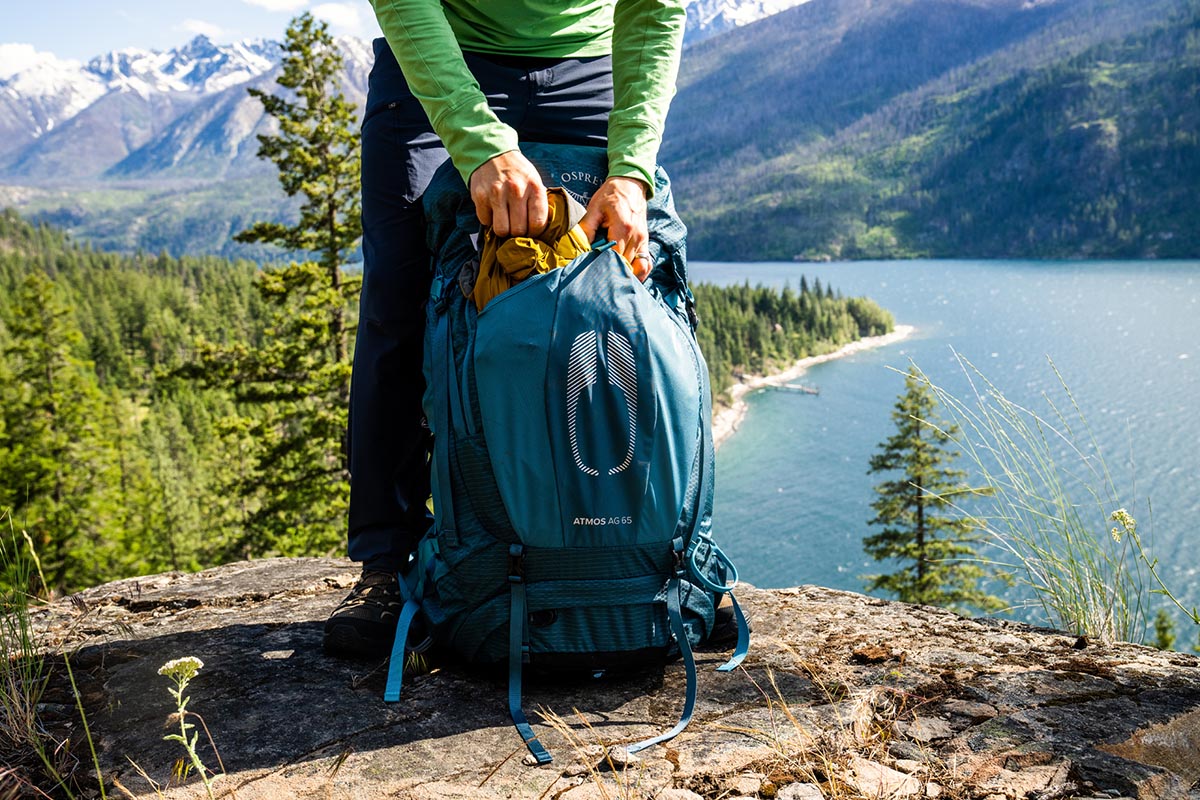
 Weight: 3 lb. 6.0 oz.
Weight: 3 lb. 6.0 oz.
Fabric: Nylon
Capacity: 60L
What we like: Decent performance for just $179; sizing is very adjustable.
What we don’t: Cheap materials and budget-feeling fit and finish.
For value seekers or those just dipping their toes into backpacking, REI’s in-house collection is a really nice place to start. The Trailmade 60 is far from the most premium pack we’ve tested—in fact, it carries the vibe of a 90s-era hauler—but it certainly gets the job done. We found the suspension to be comfortable on multi-day trips with up to 40 pounds in tow, and organization was good with a roomy main compartment, dedicated sleeping bag storage, and six external pockets. For just $179, the Trailmade 60 is an excellent pick for beginners or those who get out just a few times a year.
What do you give up by choosing REI’s entry-level pack over the pricier options on this list? In short, the fit and finish are what one would expect from a $179 pack: Materials are obviously cheap, the pack is quick to wet out in moisture, and ventilation is limited due to the lack of mesh along the backpanel. Additionally, the hipbelt pockets are too small to fit a smartphone, and we expect the squishy foam on the hipbelt, shoulder straps, and portions of the back to pack out over time. Additionally, the one-size-fits-most torso adjustment (two hipbelt sizes are offered that accommodate S to 4XL) results in a less tailored feel compared to packs that are made in multiple sizes. On the other hand, this adjustability makes the pack a great one to share. Summed up, if you’re a new or casual backpacker in the market for a no-frills pack, the REI Trailmade 60 gets our nod as the best budget design of the year.
Read more: women's REI Co-op Trailmade 60 review
See the Men's REI Co-op Trailmade 60 See the Women's REI Co-op Trailmade 60

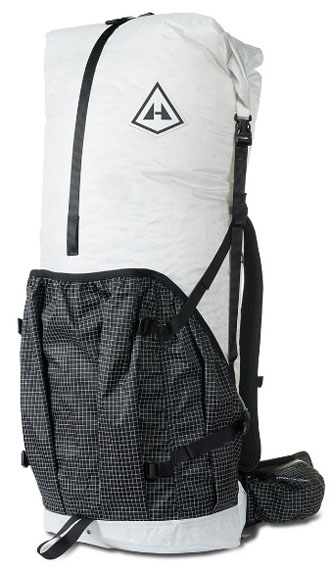 Weight: 1 lb. 15.7 oz.
Weight: 1 lb. 15.7 oz.
Fabric: DCH (50D body, 150D bottom)
Capacities: 40, 55, 70L
What we like: Impressively light but strong and can carry a full load.
What we don’t: Expensive and minimal organization.
A number of ultralight packs are designed for thru-hikers and minimalists, and our top pick is the Hyperlite Mountain Gear Southwest 55. What sets the Southwest apart is its fully Dyneema construction, which offers incredible strength and water resistance at a very low weight. Tack on a firm foam backpanel and aluminum stays, and the Southwest handles heavy loads with relative ease. For the whole enchilada at just a smidge under 2 pounds, it’s no wonder it’s one of the most popular UL packs on the trail. And Hyperlite offers a range of other options, with the primary difference being the external pocket fabric—the Windrider, for example, has mesh pockets and is a great choice for those who want to dry gear out on the go.
At 55 liters, the Southwest (which also comes in 40 and 70L versions) has the capacity to take on seriously long trips and has become a go-to pack for thru-hikers. In our hands, it has seen duty as an overnight and multi-day backpacking pack as well as a packrafting dry bag. The design is undeniably basic, with only the main compartment and a few exterior pockets for organization, and the Dyneema-lined backpanel falls short in terms of breathability. But the Southwest is still one of the most uncompromised options available, and there’s no denying the trail style you get with that premium Dyneema white. Finally, it’s also worth mentioning Hyperlite’s Unbound 55 ($399), which is a touch lighter, less torpedo-like, and offers a few more features (including external daisy chains, stretchy pockets, and a removable, reverse-pull hipbelt) but gives up a little support with just a single stay (compared to the Southwest’s two).
Read more: Hyperlite Mountain Gear Southwest 40 review
See the Hyperlite Mountain Gear Southwest 55

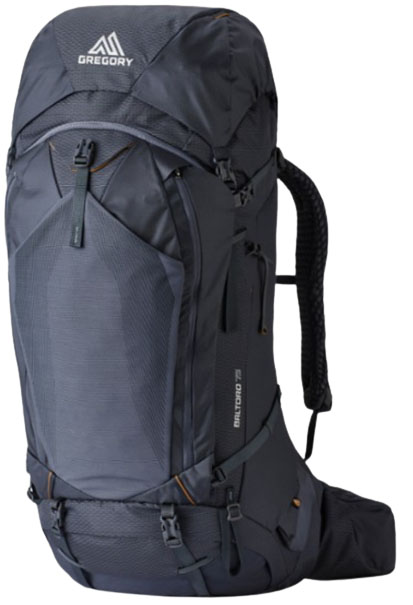 Weight: 4 lb. 15.7 oz.
Weight: 4 lb. 15.7 oz.
Fabric: Nylon (210D & 420D body, 630D bottom)
Capacities: 65, 75L
What we like: Heavy-hauling comfort with a great feature set.
What we don’t: Pretty hefty and overkill for weight-conscious backpackers.
Gregory has earned a reputation for comfort over the years, and their flagship men’s Baltoro and women’s Deva packs carry on the tradition. These bags are intended to haul heavy loads with strong suspensions, firm but supportive padding, and excellent organization. With a fully mesh backpanel, the most recent version is the best-ventilated iteration yet, and the hip-hugging suspension and pivoting shoulder straps keep the pack stable when hiking over uneven terrain. We also appreciate the generous storage layout for shuttling multi-day loads, including nine exterior pockets, U-shaped front access to the main compartment, and massive hipbelt pockets (made even larger in the latest update) that easily swallow a large smartphone.
We tested the Baltoro 75 while trekking in Patagonia, and the pack lived up to its intentions as one of the most comfortable and feature-rich designs on the market. Along with the changes outlined above, the latest version also includes a highly customizable hipbelt and shoulder straps (great for achieving a proper fit), drops the built-in Sidekick daypack (not a big loss, in our eyes), and uses more recycled materials. But as before, the Baltoro’s biggest downside is its weight: The 75-liter model clocks in around 5 pounds, which is about twice the heft of the 70-liter Hyperlite Southwest. In short, if you aim to keep things light and simple on a backpacking trip, this probably isn’t the pack for you. But if you plan to carry 40 pounds or more, the Baltoro will shoulder the load better than most—and chances are you won’t notice the extra pound or two.
Read more: men's Gregory Baltoro 75 review and women's Deva 70 review
See the Men's Gregory Baltoro 75 See the Women's Gregory Deva 70

 Weight: 2 lb. 13.4 oz.
Weight: 2 lb. 13.4 oz.
Fabric: Nylon (100D body, 100D bottom)
Capacities: 38, 48, 58L
What we like: Excellent mix of carrying comfort, ventilation, and build quality at a reasonable weight.
What we don’t: Relatively thin materials; overly complicated for many minimalists and thru-hikers.
Osprey is a backpack powerhouse known for their quality builds, excellent organization, and comfort, as seen in industry-leading designs like the Atmos/Aura above. First released over a decade ago, the Exos (and women’s Eja) was their original take on an ultralight pack and remains a popular pick in this category. At 2 pounds 13.4 ounces for the 58-liter version, it can’t compete with streamlined haulers like the Hyperlite Southwest above or Gossamer Gear Mariposa below (both of which check in around 2 lb.), but the additional weight translates to a boost in organizational features, carrying comfort, and ventilation. And with a spring 2022 update, the most recent Exos tacks on a convenient torso-length adjustment and reintroduces hipbelt pockets to the design, which had been removed in the previous version.
If you’re accustomed to a traditional backpack but curious about dipping into the UL world, we think the Exos is one of the best places to start. With a robust suspension system and practical feature set, this pack is pushing the definition of "ultralight," but it’s nevertheless significantly lighter and more streamlined than a pack like the Atmos above. And held up against the similarly intentioned Gregory Focal below, the Exos boasts a few more bells and whistles (including the adjustable torso length) and features a slightly more plush backpanel. You do trade a bit of durability compared to burly traditional haulers or pricier ultralight designs (which generally use Dyneema or tough Robic nylon), but we’ve been surprised with how well the Exos’ 100-denier (D) body and base have held up. For an even more streamlined option from Osprey, check out the Exos Pro 55 ($290), which weighs just 2 pounds 1.2 ounces and is quickly becoming a favorite among thru-hikers and minimalists willing to take a deeper dive into the UL space.
Read more: men's Osprey Exos 58 review and women's Osprey Eja 58 review
See the Men's Osprey Exos 58 See the Women's Osprey Eja 58

 Weight: 4 lb. 7.4 oz.
Weight: 4 lb. 7.4 oz.
Fabric: Polyester (400D body, 420D bottom)
Capacity: 65L
What we like: Thoughtful and well-rounded design built specifically for plus-size backpackers.
What we don’t: Only offered in one capacity and colorway.
Up until very recently, it’s been difficult (if not impossible) to find backpacking gear in plus sizes, which has excluded many from enjoying the outdoors. Gregory was one of the first companies to right this wrong, and they now offer several of their leading designs in dedicated plus-size offerings to appeal to a wider range of hikers. The Zulu 65 Plus Size is our current favorite and strays from the straight-size model with longer and wider shoulder straps, a hipbelt that fits waists from 39 to 60 inches (the straight-size Zulu can accommodate hips from 27 to 53 in.), and repositioned load lifters and hipbelt pockets for easier access. For reference, Gregory states that the Zulu 65 and women’s Jade 63 are comparable to 2X to 6X in apparel sizing, which is a healthy range and really widens overall appeal.
We were happy to see that Gregory chose the Zulu to bring to their plus-size audience, as it offers a hard-to-beat combination of carrying comfort, durability, weight, and features—all at a reasonable price point to boot. Its thickly padded straps and body-hugging suspension system move with your body over rocky and rooted trails, and the robust fabrics hold up well to frequent use. Top, front, and bottom access to the main compartment make it easy to locate gear inside, and there’s plenty of zippered storage for divvying up the essentials. We came away a little underwhelmed by ventilation and weather-worthiness in testing, but overall, the Zulu checks all the boxes for most backpackers, striking a nice middle ground between streamlined UL packs and feature-rich heavy haulers.
Read more: women's Gregory Jade 63 review (straight-size version)
See the Men's Gregory Zulu 65 Plus Size See the Women's Gregory Jade 63 Plus Size
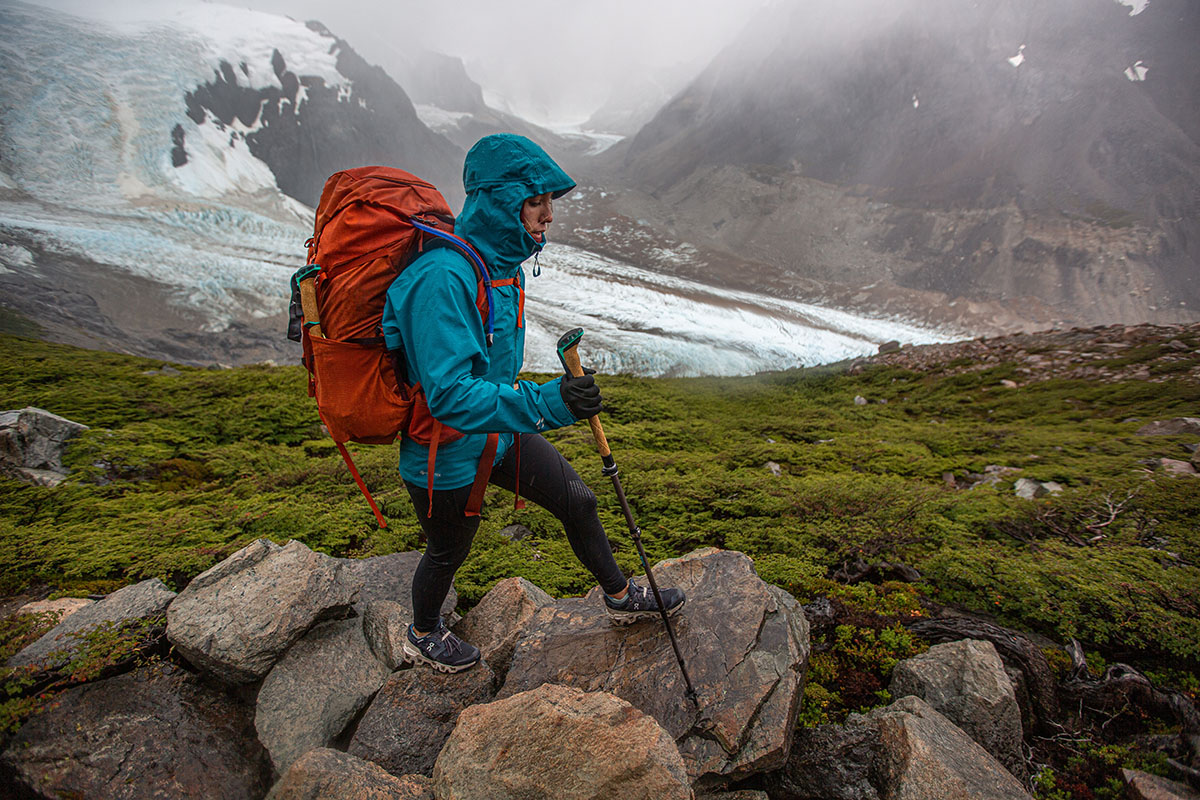
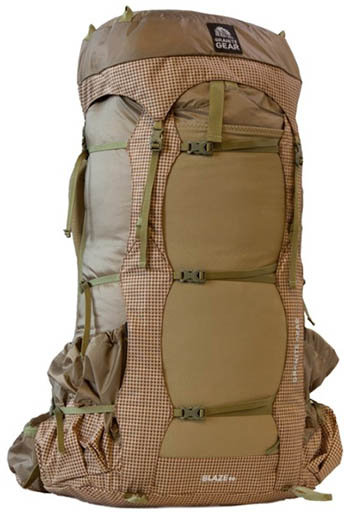 Weight: 3 lb. 0 oz.
Weight: 3 lb. 0 oz.
Fabric: Robic nylon (100D & 210D)
Capacity: 60L
What we like: Excellent mix of carrying comfort, organization, and weight.
What we don’t: Durability and back ventilation can’t match the Atmos AG above.
The Blaze 60 is Granite Gear’s flagship piece, combining heavy-hauling credentials and functional organization at a 3-pound weight. We took the pack on a difficult trek through the Grand Canyon and were pleased with its overall performance. The pack’s sturdy frame sheet and substantial padding on the hipbelt and shoulder straps carried a full load extremely well (it’s rated for 50 lb.), and the zippered opening to the main compartment made it easy to access our gear. Further, the oversized front and side exterior pockets are extremely functional (you can fit two standard water bottles in one side pocket). Most impressively, the Blaze pulls this off while undercutting most of the competition by a pound or more.
What’s not to like with the Blaze 60? The padded backpanel favors comfort and support over breathability, and we found it to be stiffer and warmer than a mesh-heavy design like the Atmos above. Moreover, it takes some practice (and patience) to get the shoulder straps and hipbelt adjusted. In particular, reaching behind the frame sheet to remove and reinsert the shoulder strap clips was a pain. But these are small nitpicks, and the Blaze’s well-rounded build makes it one of our favorite packs on the market.
Read more: women's Granite Gear Blaze 60 review
See the Men's Granite Gear Blaze 60 See the Women's Granite Gear Blaze 60
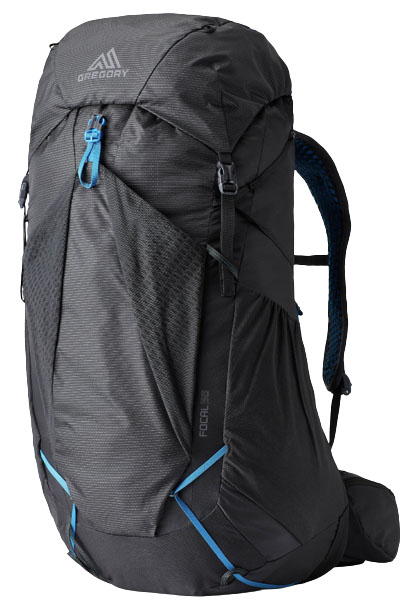 Weight: 2 lb. 10.4 oz.
Weight: 2 lb. 10.4 oz.
Fabric: Nylon (100D & 210D body, 210D bottom)
Capacities: 48, 58L
What we like: A strong alternative to the Exos above—if it fits.
What we don’t: No torso length adjustment.
Replacing the well-loved Optic, Gregory’s Focal (and women’s-specific Facet) highlights the brand’s premium ethos in an ultralight package. The pack drops weight with stripped-down features and simple organization, but comfort remains a priority: The body-hugging hipbelt, lightweight aluminum frame, and full mesh backpanel offer significantly more support than the streamlined suspension systems typically found on minimalist packs. You’ll still want to make sure the rest of your gear is appropriately pared down—especially if you’re opting for the 48-liter version—but the good news is there’s no shortage of ultralight tents, sleeping bags, sleeping pads, and other UL gear to choose from.
The Focal goes head-to-head with Osprey’s Exos above, which is the longstanding favorite in this category. Both packs come in 48- and 58-liter versions (the Exos is also available in a 38L option) and check in around the same price (the Exos is $10 less for the 58L). But the Focal is lighter by a few ounces, carries just as well, and features a simpler design that’s a bit easier to pack. The potential hangup, however, is that the Gregory lacks any torso adjustability. This isn’t especially noteworthy compared to ultralight designs—packs like the Hyperlite Southwest also feature fixed torso lengths—but it’s an undeniable shortcoming compared to the Exos. Gripes aside, if the Focal fits (it’s available in three sizes), it’s an excellent alternative for weight-conscious backpackers.
Read more: women's Gregory Facet 55 review
See the Men's Gregory Focal 58 See the Women's Gregory Facet 55
 Weight: 2 lb. 9.0 oz.
Weight: 2 lb. 9.0 oz.
Fabric: Robic nylon (400D body, 400D bottom)
Capacity: 68L
What we like: A thru-hiker favorite with functional organization, good comfort, and solid durability at a good price.
What we don’t: Not as water-resistant as a Dyneema pack.
Utah-based ULA Equipment has gone from a relative unknown to a darling of the PCT and AT in only a few short years. Leading the charge is their 68-liter Circuit, which offers an excellent balance of weight, durability, and functionality for the thru-hiking crowd and those who keep their loads under 30 pounds. The design is undeniably minimalist but retains good organization with a very large front mesh pocket, zippered hipbelt compartments, an internal secure stash, and generous side water bottle pockets (which feature the same burly fabric as the rest of the pack). We’ve taken the Circuit on multi-day treks in Patagonia and up 14ers in Colorado and have been impressed with how easy it is to load up, adjust, and even streamline as a daypack when needed.
Although the ULA Circuit doesn’t have that coveted Dyneema distinction, its 400D Robic nylon has proven to be very abrasion-resistant and is actually less prone to punctures than comparable Hyperlite and Zpacks designs (in our experience, Dyneema has a greater tendency to form small holes in between the fibers). What’s more, with a carbon fiber suspension, aluminum stay, and rigid foam backpanel, the Circuit is fully capable of utilizing its generous 68-liter capacity. To top it off, the ULA is offered in an impressive range of sizes, and you can customize the torso length, hipbelt size, and shoulder strap style to meet your needs. If you’re willing to give up the class-leading water resistance, slight weight savings, and brand cachet of the Dyneema competition, it’s likely you won’t be disappointed with the Circuit—and it’s a solid value at just $300.
See the ULA Equipment Circuit 68
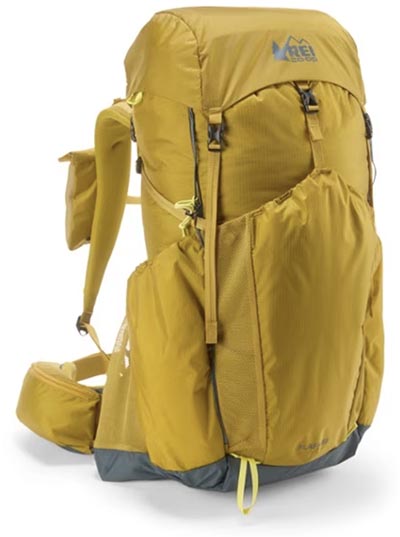 Weight: 2 lb. 13.0 oz.
Weight: 2 lb. 13.0 oz.
Fabric: Nylon
Capacity: 55L
What we like: Inexpensive, lightweight, and lots of customization options.
What we don’t: A step down in performance from the Exos and Focal above; shoulder strap pocket is prone to falling off.
REI’s packs are reliably high on value but can be hit or miss in terms of outright performance. The ultralight Flash 55 falls in the former category, featuring a competitively light weight (on par with the Exos and Focal above) and a variety of thoughtful touches, including four large side pockets (great for taller items like a tent or backpacking chair) and a front dump pocket, multiple daisy-chain attachment points, and a convenient roll-top closure. The Flash is also hallmarked by a range of customizable features (REI calls them “Packmod” accessories): Depending on the trip, you can add or remove the compression straps, two hipbelt pockets, and a shoulder strap pocket to shave off up to 7 ounces. We've tested the Flash all over the world—from long bushwhacks in East Africa to backpacking excursions in Wyoming's rugged Wind River Range—and have been impressed with its deft balance of comfort, weight, and features.
However, while the Flash 55 will save you some cash over the Exos and Focal, it’s a bit less competitive overall. Both of those packs offer improved ventilation thanks to suspended mesh along the backpanel, and they’re also a bit more comfortable when shuttling heavier loads. To be fair, we’ve approached the Flash’s 35-pound limit on multiple occasions without any major issues, but the Osprey and Gregory designs lend a sturdier, more reliable feel. We also found the REI’s shoulder strap pocket to be more annoying than useful—it was prone to catching and falling off, so we removed it within the first few miles. But all in all, you’d be hard-pressed to find a better deal among lightweight packs, making the Flash a great choice for weight- and budget-conscious backpackers willing to make some small sacrifices.
Read more: men's REI Flash 55 review and women's REI Flash 55 review
See the Men's REI Co-op Flash 55 See the Women's REI Co-op Flash 55
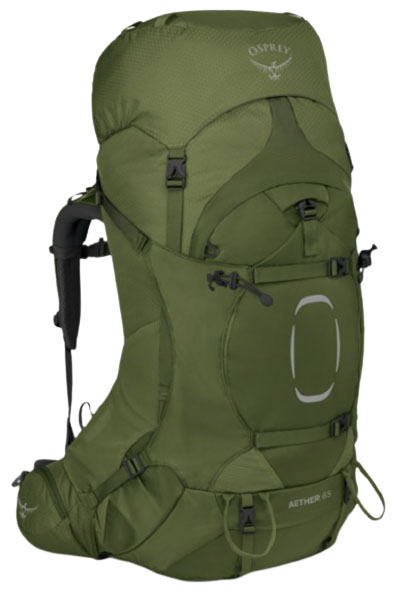 Weight: 4 lb. 14.7 oz.
Weight: 4 lb. 14.7 oz.
Fabric: Nylon (420D body, 420D bottom)
Capacities: 55, 65L
What we like: Great adjustability and very comfortable for hauling heavy loads.
What we don’t: Most backpackers are better off with the Atmos; heavy.
The Atmos AG above is Osprey’s leading backpacking pack, but for heavy hauling and light mountaineering, the Aether offers even more in the way of comfort and features. Updated a couple years ago, the pack dropped the AntiGravity (AG) suspension system for an AirScape backpanel, which is less elaborate but still has breathable foam and mesh to help keep you cool. And you get all kinds of adjustability, including a rip-and-stick system that easily tailors the fit of the shoulder straps and hipbelt, along with ample compression straps and attachment points for ice axes, tent poles, and more. Last but not least, the large J-shaped zipper at the front provides easy access to the main compartment.
The primary downside of the Aether 65 is its weight, which squeezes in just under 5 pounds. On top of that, organization is middling: You only get five external pockets (seven if you’re counting water bottle holders), and the hipbelt pockets are oddly placed and difficult to reach. For the majority of backpackers, we think the Atmos is the more practical all-around design at around 5 ounces less, and the Gregory Baltoro 75 above gets you more capacity for around the same weight (albeit for $40 more). But in terms of premium haulers, the Aether has a lot to offer, and those lugging heavy loads will appreciate the durable, sturdy build. Keep in mind that Osprey also makes the beefed-up Aether Plus and stripped-down Aether Pro, which could be great alternatives depending on your needs.
Read more: men's Osprey Aether 65 review and women's Ariel 65 review
See the Men's Osprey Aether 65 See the Women's Osprey Ariel 65
 Weight: 3 lb. 8.3 oz.
Weight: 3 lb. 8.3 oz.
Fabric: Nylon (100D & 210D body, 300D bottom)
Capacities: 50, 60, 70L
What we like: A well-balanced design with a useful feature set.
What we don’t: Heavier but no more comfortable than the Blaze above.
It doesn’t get much more premium than Gregory’s Baltoro above, but a strong case can be made for a more affordable and lightweight design like the Paragon. At 3 pounds 8.3 ounces, the Paragon 60 is a great option for smaller loads (it comes in 50, 60, and 70L versions) and those looking to save. You don’t get the same level of padding or organization as the Baltoro above, but the pack offers easy fit adjustments, plenty of mesh along the backpanel to help you stay cool, and a quality feel overall with sturdy zippers and supportive foam. And the Paragon doesn’t skimp on useful extras either, with features like a large mesh front pocket, dual access to the main compartment (via the top or full-length side zipper), a zippered sleeping bag compartment, and a bear canister-friendly shape.
With an all-rounder design that finds a nice middle ground between stripped-down UL models and heavy comfort-first haulers, the Paragon goes head-to-head with a pack like the Osprey Atmos above. But while the Gregory gets the clear edge in weight (it’s over a pound lighter) and price (by $70), the Osprey is the better pack when it comes to comfort, exterior storage, and ventilation. Further, the Atmos has a higher-end feel and more durable construction with thicker fabrics throughout. It’s also worth checking out Gregory’s Zulu 65 ($280) above, which offers top-notch ventilation but (in our experience) comes up short in terms of carrying comfort. Note: We are in the process of testing the latest version of the Paragon and will report back with detailed feedback soon. In the meantime, most of our coverage on the past-generation Paragon 58 (linked below) still holds true.
Read more: Gregory Paragon 58 review (prior version)
See the Men's Gregory Paragon 60 See the Women's Gregory Maven 58
 Weight: 2 lb. 2.2 oz.
Weight: 2 lb. 2.2 oz.
Fabric: Robic nylon (100D & 210D)
Capacity: 60L
What we like: Superlight with great organization and customization.
What we don’t: You’ll need to be careful not to overload it; low and wide design isn’t ideal for bear canisters.
The Gossamer Gear Mariposa has long been a favorite among thru-hikers, and for good reason. What sets it apart is how few compromises there are with this 2-pound-2.2-ounce bag (for a size medium with a medium hipbelt). You get a total of seven external pockets—more than the Hyperlite or ULA above—which make it easy to distribute and organize your gear. And while brands like Hyperlite and Zpacks use Dyneema to cut weight, the Gossamer Gear’s tough Robic nylon (similar to the ULA’s but thinner) keeps cost in check and does a great job resisting punctures (the downside is you’ll have to add your own waterproofing in the form of a pack cover or dry bags inside). Finally, Gossamer Gear offers great customization: The standard pack comes in three sizes, and you can order your hipbelt separately to nail that perfect fit.
Comfort-wise, we’ve found the Mariposa has sufficient padding and plenty of support right up to its 35-pound maximum rating. However, go much heavier, and the pack quickly becomes off-balance, resulting in compromised carrying comfort and weight distribution. On the bright side, Gossamer Gear did address one of our primary complaints about the past version of the pack during their most recent update: the backpanel. The removable foam padding is no longer prone to bunching, although the pack still rides lower and wider than models like the Southwest, which has a bit more of a torpedo shape— some folks might not like the look as much, but for those carrying a bear canister, it’s a really functional design. There’s no shortage of good competition in the ultralight pack market, but the Gossamer Gear is nevertheless a strong contender, especially for those who like to stay organized.
Read more: Gossamer Gear Mariposa 60 review (prior version)
See the Gossamer Gear Mariposa 60
 Weight: 5 lb. 2.6 oz.
Weight: 5 lb. 2.6 oz.
Fabric: Polyamide (235D body, 500D bottom)
Capacities: 45, 60L
What we like: Great comfort and organization for significantly less than the competition.
What we don’t: Only available in one size; limited load carrying despite being the heaviest pack here.
Germany-based Deuter has been pumping out quality packs since the early 1900s, and their current collection holds court with premium offerings from brands like Osprey and Gregory. The Aircontact Core is the brand’s all-rounder, prioritizing comfort and organization for multi-day backpacking trips. Similar to packs like the Osprey Aether and Gregory Baltoro, the Aircontact Core features a thoughtfully built suspension system and harness, an adjustable torso length, and no shortage of storage, including dual hipbelt and lid pockets and a handy J-shaped zipper on the front. We took the women’s Aircontact Core 60 + 10 SL backpacking in Washington’s Glacier Peak Wilderness and were very pleased with its comfort and convenience throughout big days on the trail.
The Deuter is a wonderful value for those who don’t want to fork over $300+ for a backpack, but it doesn’t quite measure up to the aforementioned Osprey and Gregory. The pack checks in at a similar weight as the heavy haulers, but its load limit maxes out at 44 pounds (compared to the competitors’ 55- to 60-lb. limits). Second, the Aircontact Core is only available in one size, which translates to a less tailored feel overall. But if you’re curious about trying something different than the standard fare, the Deuter is well deserving of a closer look and will save you a decent chunk of change in the process. A final bonus: Deuter will repair any of their packs free of charge, regardless of how old it is or how the damage occurred.
Read more: women's Deuter Aircontact Core 60 + 10 SL review
See the Men's Aircontact Core 65 + 10 See the Women's Aircontact Core 60 + 10 SL
 Weight: 2 lb. 9.3 oz.
Weight: 2 lb. 9.3 oz.
Fabric: Robic nylon (100D & 210D)
Capacity: 60L
What we like: Great price for a versatile and competitively lightweight pack.
What we don’t: Lacks the premium fit and finish of many competitors; short and squat build isn't our favorite.
More than any other model, the 60-liter Crown has put Granite Gear solidly on the ultralight map. Now in its third iteration—fourth if you include the old Vapor Trail—the Crown3 is one of the most affordable yet versatile options available. The pack features a plethora of customizable features, including a variety of removable straps, a top lid that doubles as a chest or fanny pack, and a roll-top closure for securing loads of varying sizes. Unlike much of the competition, the hipbelt can be adjusted to your exact waist measurement with the Crown’s Re-Fit system. And to help you maximize all 60 liters of capacity, Granite Gear offers the option of adding a lightweight aluminum stay to increase the pack’s load limit to 43 pounds (without the stay, the Crown3 maxes out at 35 lb.).
The latest Crown is the most comfortable yet, featuring a compression-molded PE frame sheet and molded foam backpanel. But after testing it on a recent three-day backpacking trip, we have our fair share of gripes. For one, the pack features a very short and squat build, which ends up feeling squirrely when loaded down (the lack of stabilizer straps connecting the hipbelt to the pack doesn’t help). Second, we found the Crown to be almost too featured—we removed a pile of straps (including front water bottle holders and a second sternum strap) before taking it into the field. And finally, it simply lacks the fit and finish of packs from companies like Osprey, Gregory, and Hyperlite. Still, if you’re looking to save money without compromising on a customizable fit and feature set, the Crown3 is a nice value pick.
Read more: women's Granite Gear Crown3 60 review
See the Men's Granite Gear Crown3 60 See the Women's Granite Gear Crown3 60
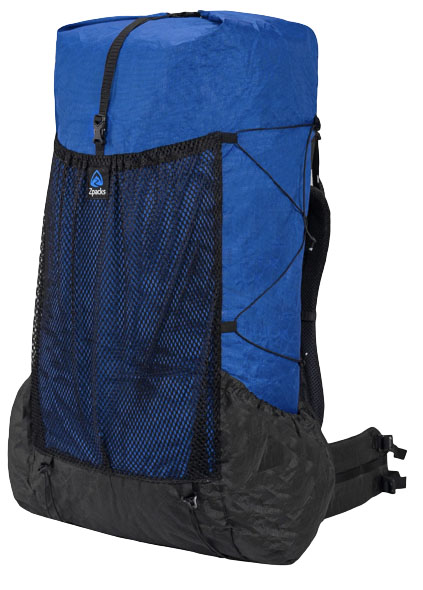 Weight: 1 lb. 5.4 oz.
Weight: 1 lb. 5.4 oz.
Fabric: Ultra (100D)
Capacity: 40, 50, 60, 70L
What we like: Incredibly lightweight, ventilated, and water-resistant.
What we don’t: Not very durable and doesn’t carry loads as well as the other UL packs here.
Weighing at least half a pound less than the next-lightest pack on our list, the Zpacks Arc Haul Ultra takes the ultralight crown. The 60-liter model we tested comes in at an amazing 1 pound 5.4 ounces, and you can tack on modular add-ons like shoulder and belt pockets or a water bottle holder to complete your setup. In terms of construction, the Arc Haul Ultra uses a 100D Ultra build, which comprises a woven UHMWPE face fabric (short for Ultra High Molecular Weight Polyethylene) laminated to a waterproof lining. Pitted against the Hyperlite Southwest above, we've found the Zpacks to be less durable overall (we got a small puncture in the bottom of our pack after putting it down on a particularly rocky section of trail), but Ultra is simple to patch, and the drop in weight will be worth it for serious thru-hikers and ounce-counters.
The “Arc” in the Zpacks’ name comes from a unique tensioning system that pulls the middle of the bag away from the back, encouraging airflow and alleviating the need for a foam backpanel. Breathability is one of Dyneema’s shortcomings, so this is a helpful design for warm weather and those prone to working up a sweat. Combined with a carbon fiber frame, the pack has a solid structure and provides good support for loads up to about 30 pounds. However, the complex nature of the Arc Haul Ultra does give us durability concerns—especially compared to the simple Hyperlite; the pack’s abundant straps, buckles, stitching, and add-on components could all be points of failure over time. All in all, it may not be durable or comfortable enough for regular weekend backpackers (hence our ranking), but if you treat it with care, the Arc Haul Ultra is an excellent option for serious hikers and minimalist trekkers.
Read more: Zpacks Arc Haul Ultra 60 review
See the Zpacks Arc Haul Ultra 60L See the Women's Zpacks Arc Haul Ultra 60L
 Weight: 4 lb. 10.0 oz.
Weight: 4 lb. 10.0 oz.
Fabric: Nylon (210D & 400D body)
Capacities: 35, 60L
What we like: Lid doubles as a daypack on short hikes from camp; REI improved access with the latest update.
What we don’t: Heavier than the prior version and still relatively dated-feeling.
The third and final REI design to make our list this season is the Traverse 60, which nicely splits the difference between the budget-friendly Trailmade and lightweight Flash 55 above. Like both of those packs, the Traverse is high on value at $249. The feature set is particularly noteworthy for the price: You get a top lid that converts to a daypack (it disconnects from the main bag extremely quickly), large and easy-to-access zippered hipbelt pockets, and dedicated attachments for trekking poles and ice axes. REI also addressed one of our main gripes about the past model during a recent update, adding a J-shaped zipper to one side of the pack for easier access to the main compartment. And we appreciate that the pack is now offered in four sizes for both men and women, spanning a healthy range of torso and waist measurements.
Why the last-place finish for the REI Traverse 60? While still a strong value at $249, the pack no longer comes with a rain cover, and weight went up by a considerable 6 ounces. REI also ditched the Packmod system, which allowed you to customize external organization. And perhaps most importantly, the Traverse still has a relatively budget feel, with less ventilation and carrying comfort than more modern designs (unlike the Baltoro or Aether above, this is not the kind of pack you want to overload). Added up, the Traverse 60 wouldn’t be our first—or even fifth—choice for avid backpackers who spend a lot of time on the trail, but it’s a fine entry-level option that won’t break the bank.
Read more: men’s REI Traverse 60 review (prior version)
See the Men's REI Co-op Traverse 60 See the Women's REI Co-op Traverse 60
| Pack | Price | Weight | Fabric (body) | Capacities | Access | Pockets |
|---|---|---|---|---|---|---|
| Osprey Atmos AG 65 | $340 | 4 lb. 9.8 oz. | Nylon (210D) | 50, 65L | Top, sides | 8 exterior |
| REI Co-op Trailmade 60 | $179 | 3 lb. 6.0 oz. | Nylon | 60L | Top | 6 exterior |
| Hyperlite Southwest 55 | $379 | 1 lb. 15.7 oz. | Dyneema (50D) | 40, 55, 70L | Top | 5 exterior |
| Gregory Baltoro 75 | $380 | 4 lb. 15.7 oz. | Nylon (210D & 420D) | 65, 75L | Top, front | 9 exterior |
| Osprey Exos 58 | $260 | 2 lb. 13.4 oz. | Nylon (100D) | 38, 48, 58L | Top | 6 exterior |
| Gregory Zulu 65 | $280 | 4 lb. 7.4 oz. | Polyester (400D) | 65L | Top, front | 7 exterior |
| Granite Gear Blaze 60 | $300 | 3 lb. 0 oz. | Robic (100D & 210D) | 60L | Top, side | 6 exterior |
| Gregory Focal 58 | $270 | 2 lb. 10.4 oz. | Nylon (100D & 210D) | 48, 58L | Top | 6 exterior |
| ULA Equipment Circuit 68 | $300 | 2 lb. 9.0 oz. | Robic nylon (400D) | 68L | Top | 5 exterior |
| REI Co-op Flash 55 | $199 | 2 lb. 13.0 oz. | Nylon | 55L | Top | 9 exterior |
| Osprey Aether 65 | $320 | 4 lb. 14.7 oz. | Nylon (420D) | 55, 65L | Top, front | 7 exterior |
| Gregory Paragon 60 | $300 | 3 lb. 8.3 oz. | Nylon (100D & 210D) | 50, 60, 70L | Top, side | 7 exterior |
| Gossamer Gear Mariposa | $315 | 2 lb. 2.2 oz. | Robic (100D & 210D) | 60L | Top | 7 exterior |
| Deuter Aircontact Core 65 | $260 | 5 lb. 2.6 oz. | Polyamide (235 & 500D) | 50+, 65+L | Top, front | 6 exterior |
| Granite Gear Crown3 60 | $260 | 2 lb. 9.3 oz. | Nylon (100D & 210D) | 60L | Top | 6 exterior |
| Zpacks Arc Haul Ultra 60L | $399 | 1 lb. 5.4 oz. | Ultra (100D) | 40, 50, 60, 70L | Top | 3 exterior |
| REI Co-op Traverse 60 | $249 | 4 lb. 10.1 oz. | Nylon (210D & 400D) | 35, 60L | Top, side | 9 exterior |
From gear-intensive, technical approaches to months-long thru-hikes across the country, the Switchback Travel team clocked endless miles in countless different backpacks to narrow in on the streamlined selection of 16 standout models above. Former editor-in-chief John Ellings drew from his romps on local trails in the Pacific Northwest and innumerable international backpacking trips to curate our initial selection of seven packs back in 2015. Senior editor Chris Carter picked up the torch in 2024 and has been attending gear shows, bugging the pros, and putting numerous models to the test ever since to stay on top of current trends and the most groundbreaking designs out there. An alumnus of each of the Triple Crown trails in the United States (AT, PCT, and CDT), Chris is an avid long-distance backpacker who continues to trek and explore around the world. Rest assured, no stone is left unturned in the upkeep of this guide.
We keep a variety of key factors in mind when analyzing the merit of a backpacking backpack. Durability, support, organizational features, and ventilation are all top considerations, and each pack has to stand out in one—or all—of these categories to warrant any real estate above. We test each pack on real-world backpacking trips to ensure we can confidently recommend any of them for your backcountry adventures (as we do with other gear like backpacking tents and sleeping bags). Finally, we know that the backpack competition is constantly evolving, which is why we've slotted this guide into an iterative update schedule to stay on top of shifts in the market and new innovations as they surface.

Rules about how big of a pack you need are not hard and fast. Multiple factors come into play, such as how many nights your trips will be, what time(s) of year you go backpacking, and if you ever plan to tack on any additional activities (e.g., packrafting or mountaineering). One point should stand out, however: Make sure to match your pack's capacity to the type of gear you'll be bringing. Do you have dated or entry-level backpacking equipment that doesn't compress well, or do you like to bring along a few extras? Then make sure to get a correspondingly cavernous pack. Alternatively, if you've dialed in your kit with lightweight and modern gear, you'll have more flexibility in size options.

The majority of backpackers take short trips—usually around one to three nights—and for those uses, a pack in the 50 to 70-liter range is most popular. With a design like the Osprey Atmos AG 50/Aura AG 50, you’ll need to keep your packed weight low, stick to the essentials, and be sure to use the aforementioned compressible gear. While at 60 liters and more, you have enough space to take on a few additional items—great for parents with kids in tow. Within each of the ranges we have listed below, you can follow those general guidelines: minimalist to bulky (or a lot of) gear.
Overnight and/or ultralight gear: 35 to 55 liters
Long weekend (2-3 nights): 50 to 70 liters
Extended trips (over 3 days): 60+ liters

Looking beyond how much space your gear takes up in a pack, it’s also important to ballpark the total weight. Backpackers often refer to the weight of their gear (minus consumables) as their base weight: Base weights range from 8 or less pounds at the low end to over 20 pounds at the high end. Tack on food, water, and fuel, and you’re looking at anything between 15 and 50 pounds on your back—or more if you’re not careful. We’re big fans of doing whatever we can to keep our gear (and food) light, as this generally correlates to more enjoyment on the trail.

Most manufacturers list a load limit or range for their packs—on our list, these vary from 15-30 pounds for the REI Co-op Flash 55 to 60 pounds for the Osprey Aether 65. There are a lot of factors that contribute to a pack’s load limit, including the materials and construction of its frame, suspension, and padding. If you don’t see a specified load limit, an easy reference point is the pack’s empty weight—as we'll touch on more below, a heavier pack is logically most often capable of hauling more weight, thanks to its beefy frame, tough fabrics, and thick padding. This comes at the cost of a heavier base weight and a less maneuverable kit—which may be fine for casual hikes on established trails but isn't the best for technical terrain. In our opinion, load limits are more of a command than a suggestion: It’s our experience that going over a pack’s specified load limit results in a noticeable drop in comfort and can actually limit the lifespan of your pack.

The backpacks on our list above range from 1 pound 5.4 ounces for the Zpacks Arc Haul Ultra 60L to 5 pounds 2.6 ounces for the Deuter Aircontact Core 65 + 10. Backpack weight is a bit of a mixed bag: On one hand, a heavier pack will add multiple pounds to your back; on the other, these packs generally have robust suspension systems and harnesses that offer an increase in comfort and load distribution compared to more minimalist designs. We’ve found that packs roughly in the 2.5- to 4.5-pound range—such as the Osprey Atmos AG 65 (4 lb. 9.8 oz.) and Gregory Focal 55 (2 lb. 10.4 oz.)—strike a really nice balance of weight and performance for loads up to about 35 pounds. If you anticipate a heavier load, it’s worth considering a heavier pack.

Ultralight Backpacking Packs
Weight is so important to many backpackers that a whole category of backpack exists based on this spec alone. Ultralight packs cut roughly 2 to 3 pounds off the weight of standard models and feature barebones organization—most have a main compartment, one or two hipbelt pockets, and a few external dump pockets. Additionally, they utilize thin but ultra-premium materials (Dyneema and Robic nylon are common) and simple suspension systems that generally include only an aluminum stay and foam backpanel. As a result, ultralight backpacks do compromise on comfort, especially when your load heads north of 30 pounds. But for ounce-counters focused on minimizing weight, the difference between a traditional and UL pack can be significant. Just make sure you have the rest of your kit dialed in before charging into the backcountry with an ultralight model, as an overloaded pack can lead to long-term discomfort or pack failure mid-trip (for a deep dive into this category, see our article on the best ultralight backpacks).

Backpacking backpacks are built to hold up to a whole lot of abuse—after all, what other piece of gear do you routinely rake past sharp branches, throw on the ground, or sit on top of? That said, not all packs are created equal, and some are much more durable than others. The fabric denier (a measure of the fabric's thickness) offers the best clue to a pack's durability—on our list, the packs range from 100D to 420D nylon, with reinforcements as strong as 500D. As expected, packs are generally reinforced at their base, in addition to common wear points like the front, lid, and hipbelt pockets.
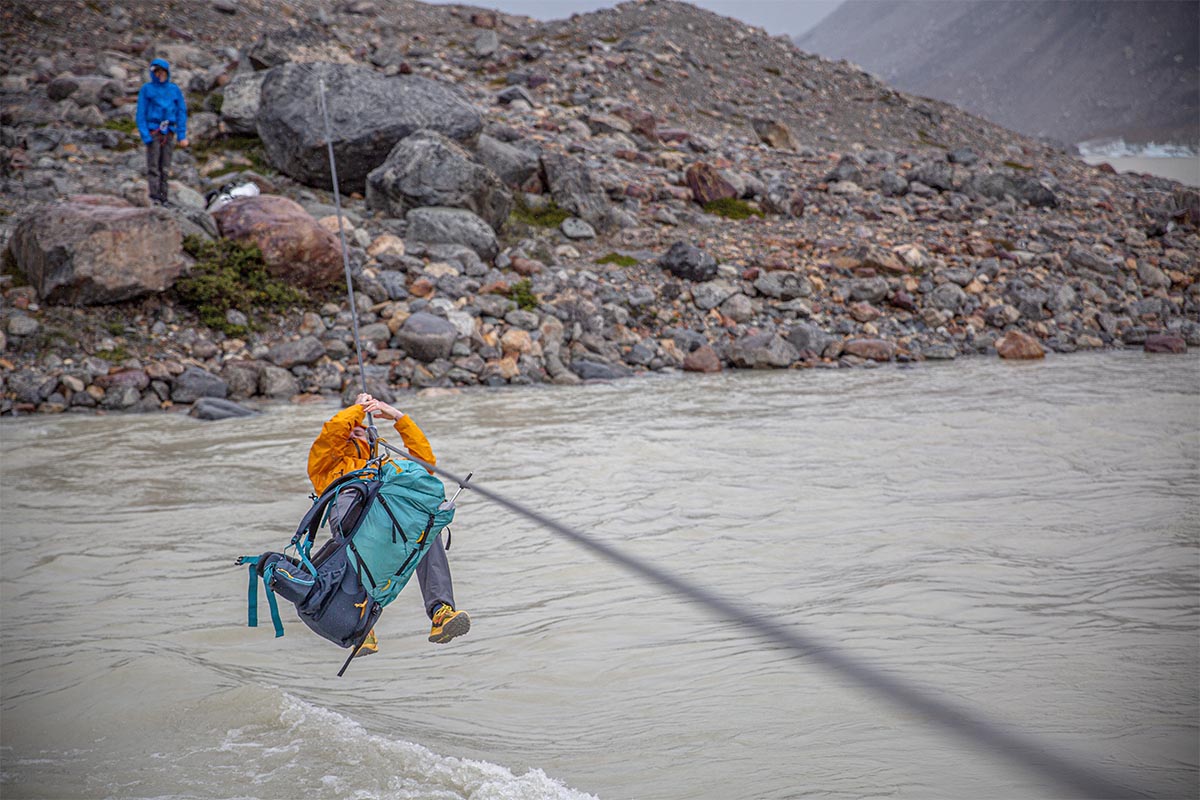
Of course, the main downside to thicker fabric is added weight. As a result, many lightweight and ultralight backpacks sacrifice a bit of durability with relatively thin builds. To maintain the best of both worlds, premium UL backpacks will often feature Dyneema or Ultra, both of which are known for their impressive strength-to-weight ratios (and steep price tags). But while it's worth being aware of a pack's fabric weight and composition, thin fabrics shouldn't necessarily be a deterrent unless you're incredibly hard on your gear, love to bushwack, or wear a backpack for work (as in the case of guides or trail crew). We've been pleasantly surprised with the durability of packs like the Gregory Focal (100D & 210D) and Osprey Exos (100D) and consider them to be sufficiently durable for most users.

All overnight packs feature foam padding in their shoulder straps and hipbelt (and sometimes backpanel), which can vary in terms of thickness and quality. The goal of the padding is to increase comfort, spread out the load, and isolate your body from the sharp contours of the pack or straps. Foam and the fabric that covers it do add ounces, so manufacturers are always trying to find the right balance of weight and comfort. In general, heavier packs offer more padding (and thus more comfort), while lighter and ultralight packs feature streamlined padding (and thus less comfort, especially with a heavy load).

We prefer foam that errs towards firm support rather than being soft and compressible. Excessively soft padding might feel great when first trying on a pack, but it doesn’t offer the long-term support needed for hauling heavier loads. Packs like the Gregory Baltoro/Deva and Osprey Aether/Ariel are great examples of effective use of this type of high-quality, firm padding. On the other hand, many modern designs (like the Osprey Atmos or Exos) swap out some padding in lieu of suspended mesh, which achieves a similar effect with less weight (and more ventilation). We were at first skeptical of the suspended mesh design, but after many years of testing various iterations, we’re full converts. With loads under 40 pounds, these airy backpanels offer just as much comfort as the padded competition.

When you’re playing the part of a moving van, carrying all your possessions in one place, organization is of utmost importance. As expected, storage options increase with a pack’s weight. Ultralight packs often feature just one cavernous compartment and a number of external pockets, while luxury designs offer a dedicated sleeping bag compartment, multiple access points to the main compartment, a lid, and a few external zip pockets. That said, more isn’t always better: How much organization you need ultimately comes down to a matter of personal preference.
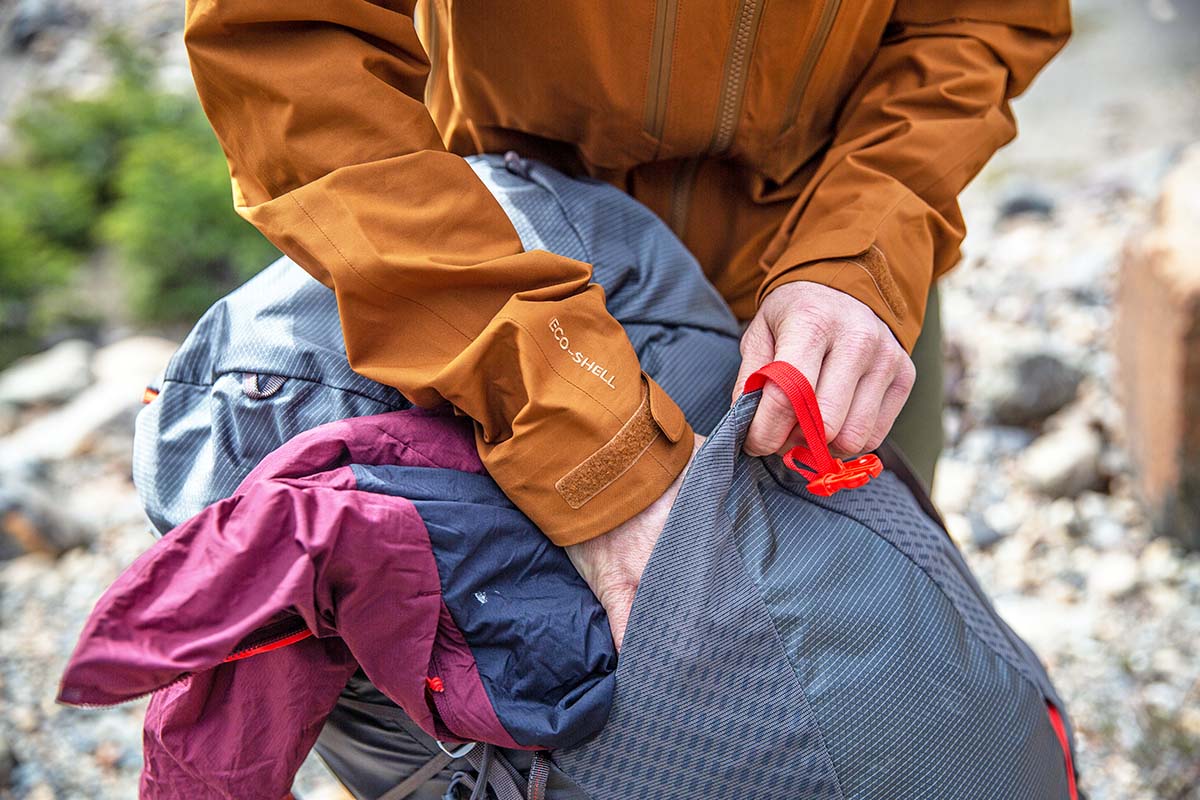
Exterior Pockets
In our comparison table above, we list the number of external pockets for each pack. Most designs feature at least five—three dump pockets and two hipbelt pockets—while many high-end packs tack on a few more. Hipbelt pockets are indispensable for quick access to items like lip balm, a phone, or Lifesavers (a great energy boost on the trail). We’ll almost always keep a layer or two in the front dump pocket, and side dump pockets are ideal for items like water bottles or trekking poles. Finally, most packs also feature a top lid with one or two zippered pockets—this is a great place to store small items like a headlamp or trail snacks, and can be removed for toting essentials around camp. But before you go pocket-crazy, just remember that sometimes, less is more: five to six pockets is just right for us, while nine can be a recipe for misplacing your gear.

Main Compartment Access
Nearly every backpacking pack out there will have an opening at the top that is secured in a cinch cord or roll-top manner, referred to as a top-loader. Additional access to the bottom or middle of the pack via a side zip(s) or U-shaped opening can be a big help, keeping you from having to shovel through a once-meticulously organized pack to find some elusive item. These extra zippers add a little weight, but are often worth it. In cases like the Gregory Baltoro/Deva or Osprey Aether/Ariel, the U-shaped opening is so wide that you can pack and remove items much like a travel suitcase.
.jpg)
Sleeping Bag Compartment
Feature-rich backpacks will often include dedicated sleeping bag storage, which is almost always located below the main compartment. This pocket generally opens with a zipper, is large enough to accommodate most sleeping bags (even relatively bulky ones), and includes external compression straps to eliminate dead space. Sometimes, manufacturers make it possible to merge the sleeping bag compartment with the main compartment by adding a zipper to the divider. However, all of this adds weight and bulk and doesn’t result in the most streamlined load. In the end, we prefer designs without sleeping bag compartments, which allow the freedom to stuff our sleeping bag in a compression sack and toss it—along with our tent—at the bottom of the pack. For a deeper dive into proper organization, check out our article on How to Pack a Backpack.

Water Reservoir (Bladder) Compatibility
Water reservoirs have become our (and most hikers') preferred way of staying hydrated on the trail, thanks to their on-the-go convenience. As a result, the vast majority of backpacking backpacks offer a number of features to accommodate reservoirs. Look for either a dedicated sleeve or clip from which to hang the reservoir, in addition to an exit port for the tube and straps or clips to secure the tube to the shoulder strap. It is worth noting that you'll want to pack your hydration bladder first before loading the rest of your gear into your pack, so that it can hang freely along the length of the backpanel. But don't fret: If you're anything like us and forget about it until your pack is fully packed, you can always rest it on top of your gear. To keep it from sloshing, invert it first and suck all of the air out of the reservoir.
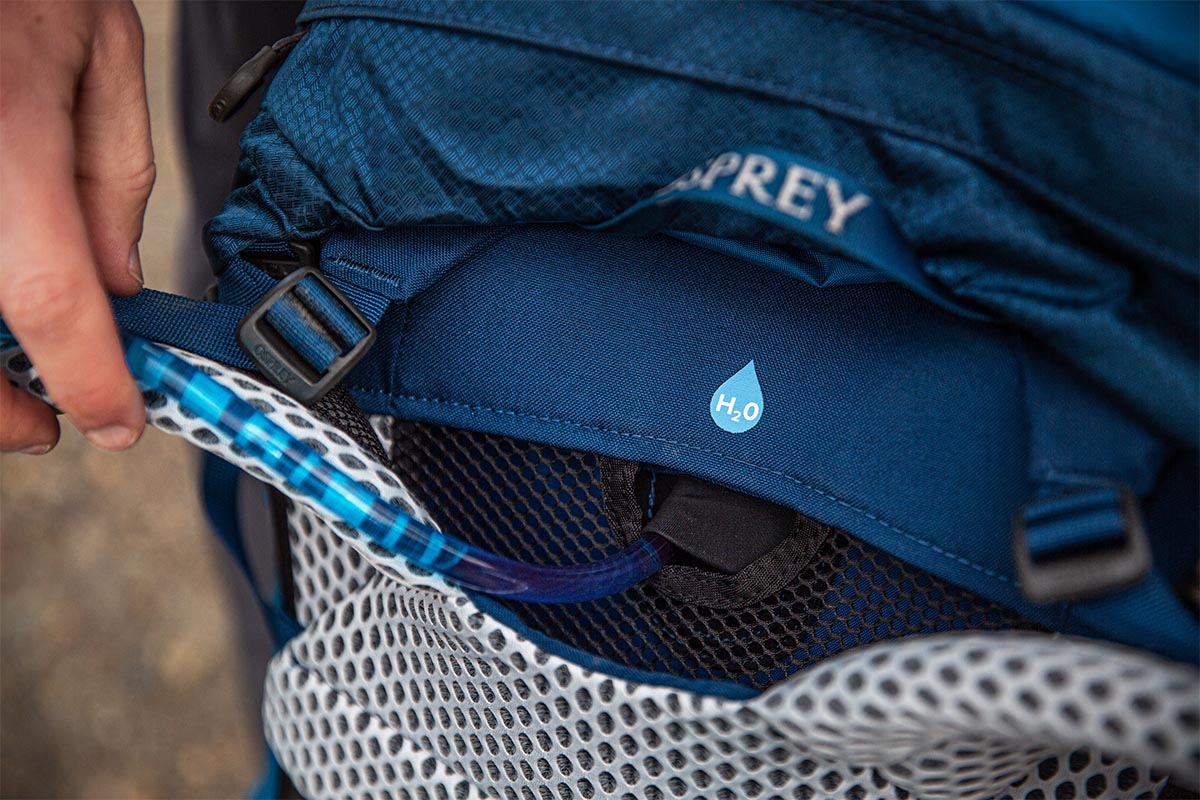
Compression Straps
Compression straps tighten a pack from front to back and pull the load close to your body, helping to keep you balanced on the trail. Make sure the pack you’re looking at has these side compression straps at both the top and bottom to aid in load stability and give them a good cinch each time you put your pack on. These straps are also useful for storing taller items (such as tent poles) along the side of your pack. When used for this purpose we especially like a system like REI's Packmod—seen on the Flash 55 pack—which allows you to move the straps to your preferred height via a series of daisy chains (or remove them altogether). And while some compression straps secure tightly with a simple plastic cinch, we prefer those with buckles for their ease of use, especially when attaching larger items like a sleeping pad.
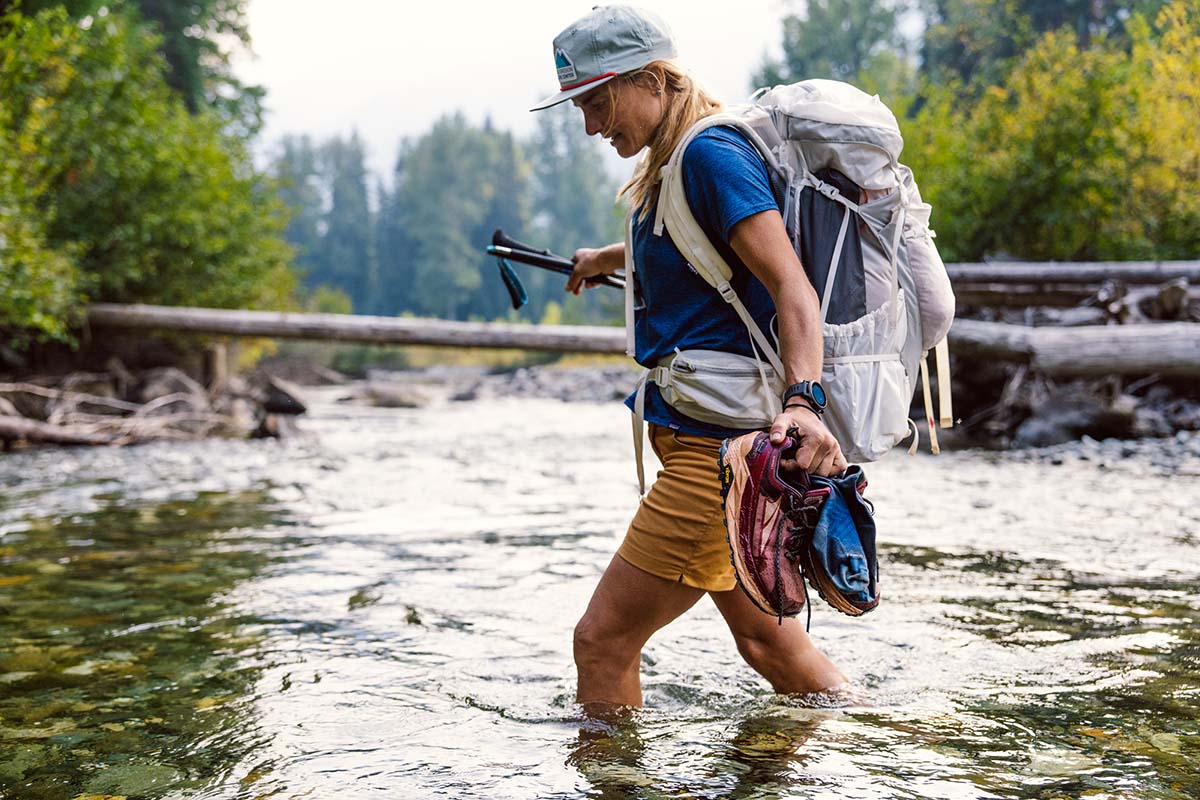
Backpanel and hipbelt ventilation is a biggie for some, especially if you tend to run warm or plan on hiking in the heat of the summer. But finding an internal framed pack that breathes well can be a challenge, primarily because the point of a pack is to hug and conform to your body, moving with you as you walk. Most packs have offsetting foam and mesh panels that do a passable job encouraging airflow, but you’ll likely still get sweat art on your back that traces where the foam panels contact your body. On the other hand, designs such as Osprey’s Anti-Gravity (seen on the Atmos/Aura) or Gregory’s FreeFloat (on the Focal/Facet, for example) feature a fully suspended mesh backpanel and hipbelt that cradle the body while still allowing for great airflow. For the most part, we love this design and recommend it for those who want to prioritize ventilation, but it does cut a bit into the main compartment’s capacity and won’t hold up to especially heavy loads.
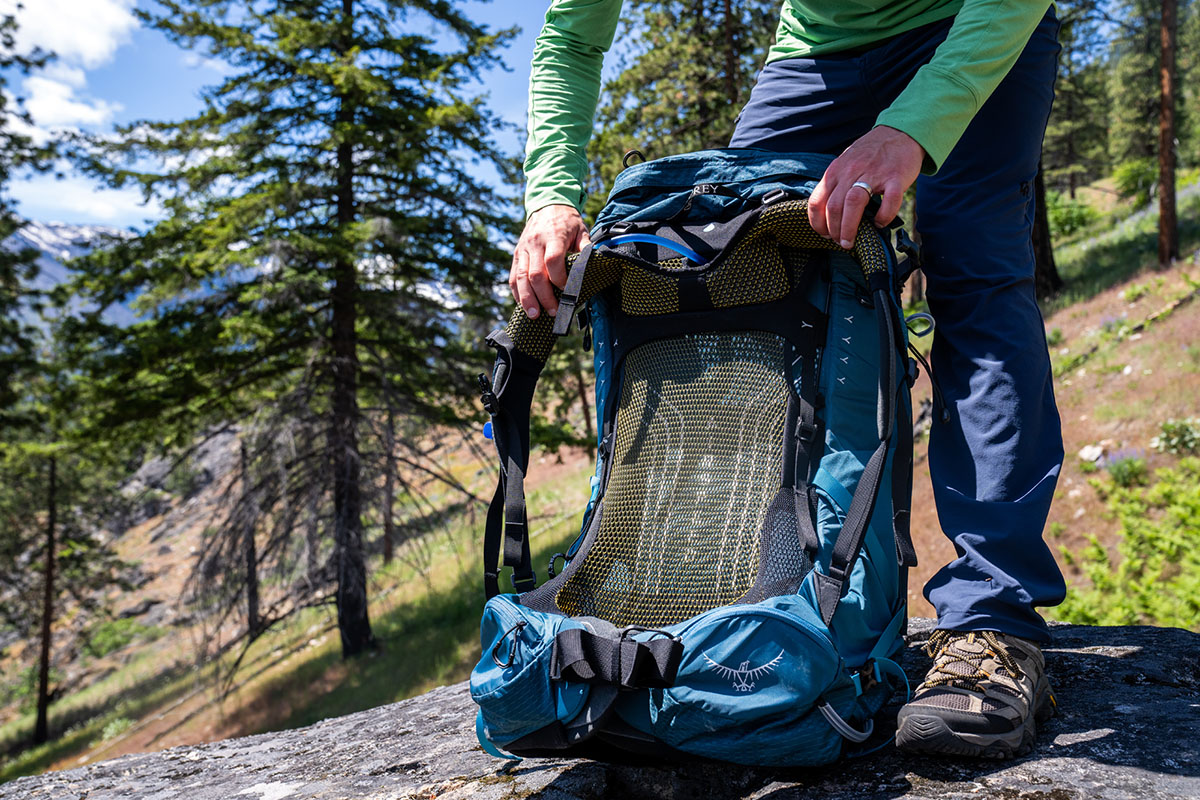
Many items that we store in our backpacks are vulnerable to moisture—including a camera, phone, and down sleeping bag—so we place a high priority on water protection. The good news is that most backpacks offer decent water resistance with hard-face nylon and a durable water repellant (DWR) coating, although expect sustained rainfall to penetrate the fabric. There are also a number of waterproof backpacks on the market, including those made with Dyneema or Ultra fabrics. In fact, we’ve used the 100% Dyneema Hyperlite Windrider as a dry bag (see our in-depth review) and it didn’t let us down.
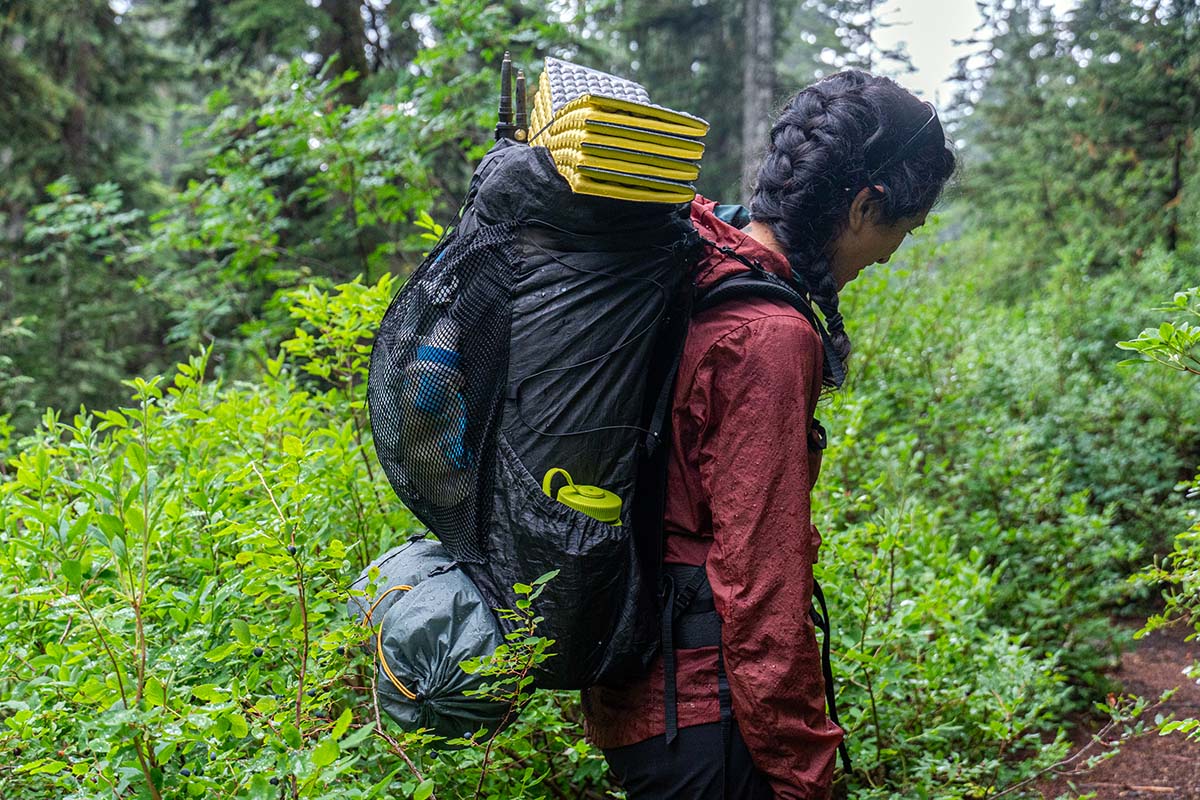
If you don’t have a waterproof backpack (chances are you won’t), it’s a good idea take a few extra precautions to make sure your gear stays dry. Some packs include a built-in waterproof cover that stows away inside the pack (the Gregory Baltoro/Deva for example). You can also purchase one separately—REI Co-op's Duck's Back Raincover ($40) gets the job done—but keep in mind that they aren’t foolproof and can be hard to trust in windy conditions.

A final strategy is to protect items from the inside, either by lining the entire pack body with a waterproof bag or using an assortment of waterproof stuff sacks or dry bags. You can even make do with garbage bags in a pinch—when guiding in British Columbia’s wet Coast Mountains, we used a trash compactor bag to line our backpack and experienced zero leaks or issues. Regardless of the liner you choose, it will work best with backpacks that feature a cavernous main compartment, like what you get with many ultralight designs.

Two of the most popular waterproof pack liners are Nylofume bags, such as this one sold by Garage Grown Gear, and polyethylene bags, such as this one from Gossamer Gear. Both are fantastic alternatives to trash bags or rain covers and can also serve as odor barriers when tied off securely at the top. For reference, one Nylofume liner kept a tester's gear safe and dry for an entire three-month thru-hike of the Appalachian Trail. These things are relatively cheap, way stronger than they appear at first glance, and add negligible weight to your pack.

One of the most important factors to enjoyment on the trail comes in sizing and fitting your pack correctly. Packs generally come in men’s and women’s versions (for a full look at the women's market, see our article on the best women's backpacking backpacks) and are offered in one to three sizes. These sizes vary most in terms of torso and hip measurements and are most often differentiated by their torso length. Hipbelts are generally very adjustable, but if your hip measurement is not proportional to your torso, it might be a good idea to opt for a pack with a customizable hipbelt. And once you dial in your size, there is still a lot of potential for adjustment, both before you put your pack on and once it’s loaded. In most cases, you can tweak the torso length by a good margin, and the majority of packs allow you to adjust the height of the hipbelt, too. For a full breakdown of dialing in the proper fit, see our Backpack Fit and Sizing Guide.

Importantly, some brands have also started to offer their most popular backpacks in extended and plus sizes. Our current favorite is Gregory's Zulu 65 and women's Jade 63, and Osprey offers several of their leading designs in Extended Fit variations, including their heavy-hauling Aether and Ariel. These packs don’t just increase dimensions; rather, they’re thoughtfully built with a wider distance between shoulder straps, well-placed hipbelt pockets, and lots of room for adjustment throughout (you can read more about Osprey’s Extended Fit collection here and Gregory’s Plus Sizing here). Options still are fairly limited, but we look forward to seeing more plus-size backpacks in the not-so-distant future.

Our impact on the environment has never been of greater concern, and it’s nice to see gear companies step it up with more sustainable practices. The use of recycled fabrics has grown substantially in the past few years, with companies like Osprey, Gregory, and Deuter prioritizing these materials. We're also seeing a lot more PFAS-free durable water-repellent (DWR) finishes on backpacks, which eliminate the use of some—or at times, all—per- and polyfluoroalkyl substances (these “forever chemicals” have been linked to a range of environmental and health issues). With many states stepping up to ban the sale of items that include PFAS, the outdoor industry is seeking better solutions for water- and stain-resistant finishes (you can read more about Patagonia’s take on the issue here). All told, it’s an exciting time for sustainability, and we’re happy to see this reflected in the backpacking pack market.
Back to Our Top Backpacking Pack Picks Back to Our Backpacking Pack Comparison Table